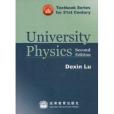《University Physics》是2006年高等教育出版社出版的圖書,作者是盧德馨。
基本介紹
- 中文名:University Physics
- 作者:盧德馨
- 出版社:高等教育出版社
- 出版時間:2006年1月1日
- 頁數:566 頁
- 定價:80 元
- 開本:16 開
- ISBN:7040118467, 9787040118469
- 語種:英語
內容簡介,圖書目錄,作者簡介,
內容簡介
《University Physics》可作為理科各專業大學物理課程的教材,也可供其他專業和社會讀者閱讀。
《University Physics》是面向21世紀課程教材,是在原第一版的基礎上修訂而成的,原第一版獲2002年度國家級優秀教材一等獎。《University Physics》是作者多年教改的成果,與國內同類教材相比,《University Physics》在內容、體系上均有較大創新。全書包括Accretion, AMS, Bose-Einstein condensation, cold fusion, clusters, DNA double-helix structure, Einstein field equation, fractals, grand unification, helix-coil transition, inflationary universe model, Ising model, jets from star, k-space, laser, light spectrum, Mossbauer effect, neutrino mass, optical pumping, quark model, quasi-crystal, three kinds of redshifts, SOC, tidal disruption, universe models, virtual pair, W±, X ray, Yukawa model, Z0等內容。
圖書目錄
Chapter 1 Intoduction
1.1 what is physics
1.2 Physical quantities
1.3 Approximation in physics
1.4 Vectors
1.5 Orthgonal coordinate systems
Problems
References
Part one Mechanics
Chapter 2 Kinematics
2.1 Mechanical motion and moving object
2.2 Translation
2.3 Rotation
2.4 Oscillation
2.5 Phase space
2.6 Galilean transformation
*2.7Coriolis acceleration
Problems
References
Chapter 3 Particle Dynamics
3.1 The law of inertia and inertial frame of reference
3.2 Newton’s second and third laws
3.3 Forces
3.4 Noninertial frame of reference and inertial force
3.5 Momentum and angular momentum
3.6 Mechanical work and energy
Problems
References
Chapter 4 Gravitation
4.1 The law of gravitation
4.2 Gravitational potential energy
4.3 Gravitational mass,redshift,and collapse
4.4 Kepler problem and scattering
4.5 Gravitational field
Problems
References
Chapter 5 Dynamics of Many—Particle System
5.1 The center of mass
5.2 System with variable mass
5.3 Collisions
5.4 F1uid motion
5.5 Symmnetry and conservation laws
Problems
References
Chapter 6 Dynamics of a Rigid Body
6.1 Rotational inertia
6.2 The dynamics of rotation
6.3 Precession of angular momentum
6.4 Equilibrium of rigid bodies and stability
Problems
References
Chapter 7 Oscillations
7.1 Simple harmonic motion
7.2 Coupled oscillation
7.3 Damped oscillation
*7.4 Nonlinear oscillation
7.5 Forced oscillation under friction
Problems
References
Chapter 8 Waves
8.1 Waves and their classification
8.2 Wave equation
8.3 Simple harmonic waves and their superposition
8.4 Interference and diffraction
*8.5Dispersion and wave packet
8.6 The Doppler effect
*8.7Solitary wave
Problems
References
Chapter 9 Relativistic Mechanics
9.1 Galilean transformations
9.2 The Lorentz transsformations
*9.3Space time diagram and twin paradox
9.4 Relativistic kinematics
9.5 Relativistic dynamics
Problems
References
Part Two Thermal Physics
Chapter 10 Temperature
10.1 Equilibrium state
10.2 Thermal equilibrium and temperature
10.3 Empirical temperature scales
10.4 The equation of state
Problems
References
Chapter 11 The First law of Thermodynamics
11.1 Work and internal energy
11.2 Heat and the first law of thermodynamics
11.3 Heat capacity and specific heat
11.4 Free expansion and internal energy of gas
11.5 Adiabatic equation
11.6 The Carnot cycIe
Problelms
References
Chapter 12 The second Law of Thermodynamics
12.1 The second law
12.2 Carnot theorem and thermodynamic scale
12.3 Entropy and entropy principle
12.4 Thermodynamic potentials
*12.5 Relativistic thermodynamics
*12.6 B1ackhole thermodynamics
Problems
References
13.2 Equilibrium distribution
13.3 Equipartition theorem
13.4 Effusion
13.5 Transport phenomena
Problems
References
Chapter 14 Phase Transition
14.1 Van der Waals equation
14.2 Phase and phase diagram
14.3 Clapeyron's equation
14.4 Higher order phase transition
14.5 Concepts in modem theory of phase transition
Problems
References
Part Three Electromagnetism
Chapter 15 Electrostatic Field
15.1 Electric charge and Coulomb's law
15.2 Electrostatic field
15.3 Gauss' law
15.4 Electric potential
15.5 Electric potential energy
Problems
References
Chapter 16 Conductor and Dielectrics
16.1 Uniform conductor in an electrostatic field
16.2 Capacitance
16.3 Conductivity and Ohm's law
16.4 Dielectrics
16.5 Electric vectors
Problems
References
Chapter 17 Magnetic Field
17.1 Magnetic field
17.2 Gauss' law for magnetism and Ampre's law
17.3 Magnetic force
17.4 The Hall effect
Part Four Fundamental Modern Physics
Appendix
作者簡介
Prof. Lu has long been engaged in the research of theoretical physics in Nanjing University, Northeastern University in Boston, University of Vermont, and The University of New South Wales in Sydney. His field is statistical physics, especially low dimensional many-body systems. During these ten years he also devoted himself enthusiastically to the education initiative. As Dean of School of Intensive Instruction in Sciences and Arts Nanjing University, he concerns reform of introductory physics course very much. This book is the result of 13 years practice. Besides physics his interests include music, and swimming. He is an amateur photographer and go player.

